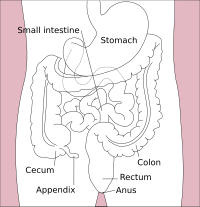| Rectum | |
|---|---|
 Anatomy of the human rectum | |
 Scheme of digestive tract, with rectum marked | |
| Details | |
| Precursor | Hindgut |
| Part of | Large intestine |
| System | Gastrointestinal system |
| Artery | Superior rectal artery (first two-thirds of rectum), middle rectal artery (last third of rectum) |
| Vein | Superior rectal veins, middle rectal veins |
| Nerve | Inferior anal nerves, inferior mesenteric ganglia[1] |
| Lymph | Inferior mesenteric lymph nodes, pararectal lymph nodes, internal iliac lymph nodes, deep inguinal lymph nodes |
| Function | Store feces prior to defecation |
| Identifiers | |
| Latin | rectum intestinum |
| MeSH | D012007 |
| TA98 | A05.7.04.001 |
| TA2 | 2998 |
| FMA | 14544 |
| Anatomical terminology | |
 |
| Major parts of the |
| Gastrointestinal tract |
|---|
The rectum (pl.: rectums or recta) is the final straight portion of the large intestine in humans and some other mammals, and the gut in others. The adult human rectum is about 12 centimetres (4.7 in) long,[2] and begins at the rectosigmoid junction (the end of the sigmoid colon) at the level of the third sacral vertebra or the sacral promontory depending upon what definition is used.[3] Its diameter is similar to that of the sigmoid colon at its commencement, but it is dilated near its termination, forming the rectal ampulla.[4] It terminates at the level of the anorectal ring (the level of the puborectalis sling) or the dentate line, again depending upon which definition is used.[3] In humans, the rectum is followed by the anal canal, which is about 4 centimetres (1.6 in) long, before the gastrointestinal tract terminates at the anal verge. The word rectum comes from the Latin rēctum intestīnum, meaning straight intestine.
- ^ Nosek, Thomas M. "Section 6/6ch2/s6ch2_30". Essentials of Human Physiology. Archived from the original on 2016-03-24.
- ^ "12. Colon and Rectum" (PDF), AJCC Cancer Staging Atlas, American Joint Committee on Cancer, 2006, p. 109, archived from the original (PDF) on 2018-06-12, retrieved 2017-09-10
- ^ a b Wolff BG, Fleshman JW, Beck DE, Pemberton JH, Wexner SD, Church JM, Garcia-Aguilar J, Roberts PL, Saclarides TJ, eds. (2007). The ASCRS textbook of colon and rectal surgery. New York: Springer. ISBN 978-0-387-24846-2.
- ^ Wang, Yun Hwa W.; Wiseman, Jeffrey (2023). "Anatomy, Abdomen and Pelvis, Rectum". StatPearls. StatPearls Publishing. PMID 30725930. Retrieved 24 May 2023.